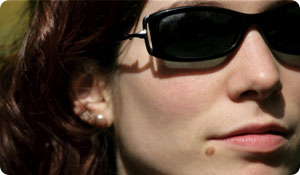
While it does not get quite as much press as breast or prostate cancer, skin cancer is actually the most common form of cancer. Physicians diagnose about one million people with non-melanoma skin cancer every year and attribute about 90 percent of these cases to sun exposure.
Your skin has two layers. The outer layer is the epidermis, and the inner layer is the dermis. Most of us have moles on our skin, which are clusters of pigmented cells called melanocytes. The average person has about 10 to 40 moles on his or her body. Moles come in different colors, can be round or oval, and are generally smaller than a pencil eraser.
Skin Cancer Risks
Sun exposure is the major risk factor for skin cancer. Contrary to popular belief, most of our sun exposure does not occur during childhood. In fact, we acquire 80 percent of our lifetime sun exposure after age 18.
Fair-skinned people are at greater risk for skin cancer. Additionally, people who have more than 50 moles are also at a heightened risk. A family history of skin cancer and age both increase your risk as well.
Do You Have Skin Cancer?
Doctors recommend that you check yourself regularly for signs of skin cancers. Through regular exams, you'll learn what is normal for you so you can easily recognize differences. Changes in existing moles, new moles or sores that do not properly heal may be signs of skin cancer.
Checking for skin cancer is as easy as A, B, C...and D. This simple system makes it easy to remember what to look for.
- Asymmetry: Is half of a mole or birthmark different from the other half?
- Border: Are the edges irregular, ragged, notched, or blurred?
- Color: Does the color vary? Is it shades of brown or black, or have patches of pink, red, white, or blue?
- Diameter: Is the spot is larger than six millimeters (about ¼ inch) wide, or larger than a pencil eraser?
When looking for signs of cancer, check the skin on your entire body, from head to toe. Experts recommend you develop the habit of checking yourself after showering, preferably in a room that has plenty of light. Full-length and hand-held mirrors help you see large surfaces, such as your back, as well as hard-to-see areas.
If you notice a change, or see anything that fits one of the descriptions above, see a dermatologist right away.
Sources





